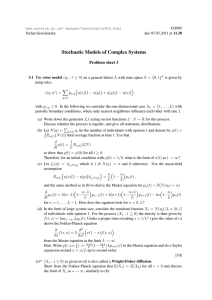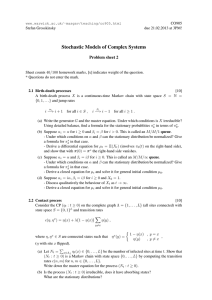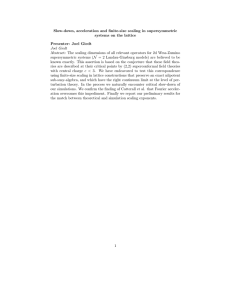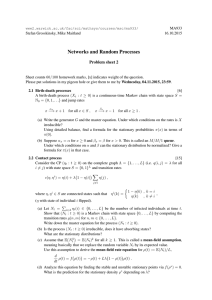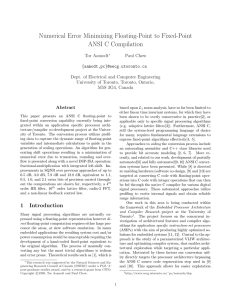Stochastic Models of Complex Systems Problem sheet 3
advertisement
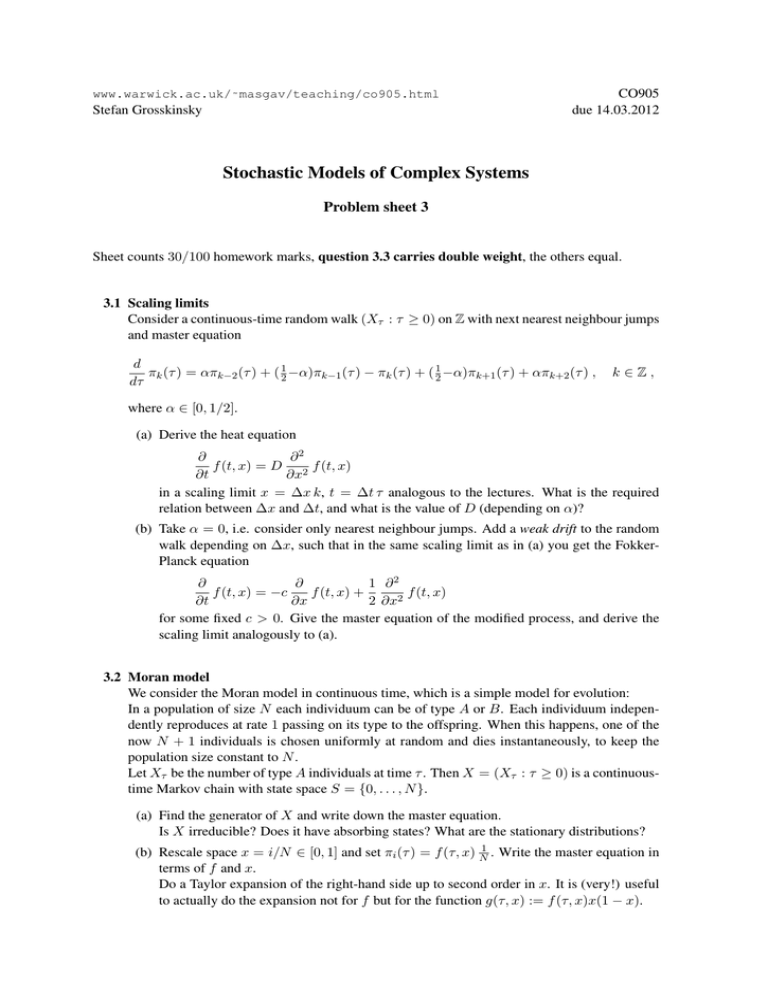
www.warwick.ac.uk/˜masgav/teaching/co905.html
Stefan Grosskinsky
CO905
due 14.03.2012
Stochastic Models of Complex Systems
Problem sheet 3
Sheet counts 30/100 homework marks, question 3.3 carries double weight, the others equal.
3.1 Scaling limits
Consider a continuous-time random walk (Xτ : τ ≥ 0) on Z with next nearest neighbour jumps
and master equation
d
πk (τ ) = απk−2 (τ ) + ( 12 −α)πk−1 (τ ) − πk (τ ) + ( 21 −α)πk+1 (τ ) + απk+2 (τ ) ,
dτ
k∈Z,
where α ∈ [0, 1/2].
(a) Derive the heat equation
∂2
∂
f (t, x) = D 2 f (t, x)
∂t
∂x
in a scaling limit x = ∆x k, t = ∆t τ analogous to the lectures. What is the required
relation between ∆x and ∆t, and what is the value of D (depending on α)?
(b) Take α = 0, i.e. consider only nearest neighbour jumps. Add a weak drift to the random
walk depending on ∆x, such that in the same scaling limit as in (a) you get the FokkerPlanck equation
∂
∂
1 ∂2
f (t, x) = −c
f (t, x) +
f (t, x)
∂t
∂x
2 ∂x2
for some fixed c > 0. Give the master equation of the modified process, and derive the
scaling limit analogously to (a).
3.2 Moran model
We consider the Moran model in continuous time, which is a simple model for evolution:
In a population of size N each individuum can be of type A or B. Each individuum independently reproduces at rate 1 passing on its type to the offspring. When this happens, one of the
now N + 1 individuals is chosen uniformly at random and dies instantaneously, to keep the
population size constant to N .
Let Xτ be the number of type A individuals at time τ . Then X = (Xτ : τ ≥ 0) is a continuoustime Markov chain with state space S = {0, . . . , N }.
(a) Find the generator of X and write down the master equation.
Is X irreducible? Does it have absorbing states? What are the stationary distributions?
(b) Rescale space x = i/N ∈ [0, 1] and set πi (τ ) = f (τ, x) N1 . Write the master equation in
terms of f and x.
Do a Taylor expansion of the right-hand side up to second order in x. It is (very!) useful
to actually do the expansion not for f but for the function g(τ, x) := f (τ, x)x(1 − x).
(c) Rescale time appropriately (t = ∆t τ ) and derive the Fokker-Planck equation
∂
∂2 ∗
f (t, x) =
x(1
−
x)f
(t,
x)
=
(L
f
)(t,
x)
∂t
∂x2
in the limit N → ∞. How are ∆t and N related?
(d) The limiting process (Yt : t ≥ 0) on [0, 1] from (c) is calledWright-Fisher diffusion.
d
Give the generator L of that process, such that dt
E g(Yt ) = E (Lg)(Yt )
for observables g : [0, 1] → R.
Show that E(Yt ) = E(Y0 ) for all t > 0 and discuss the limit of Yt as t → ∞.
(e)* For Y0 = 1/2, derive an equation for Var(Yt ), solve it, and interpret its solution.
(f)* Repeat the analysis in (a) to (c) with an additional mutation rate µ/N , µ > 0 at which an
individuum spontaneously changes type.
3.3 Simulation of the contact process.
(Sample code on the course webpage)
Consider the contact process (ηt : t ≥ 0) as defined in Q2.2, but now on the one-dimensional
lattice ΛL = {1, . . . , L} with connections only between nearest neighbours and periodic boundary conditions.
The critical value λc is defined such that the infection on the infinite lattice Λ = Z started from
the fully infected lattice dies out for λ < λc , and survives for λ > λc . It is known numerically
up to several digits, depends on the dimension, and lies in the interval [1, 2] in our case.
(a) Simulate the process with initial condition η(x) = 1 for allPx ∈ Λ and several values of
λ ∈ [1, 2]. Plot the number of infected individuals Nt = x∈ΛL ηt (x) as a function of
time averaging over 100 realizations in a double-logarithmic plot.
What is the expected behaviour of Nt depending on λ for times up to order L?
For a given system size L, find the window of interest choosing λ = 1, 1.2, . . . , 1.8, 2 and
then use increments 0.01 for λ to find an estimate of the critical value λc (L) ∈ [1, 2].
Repeat this for different lattice sizes, e.g. L = 64, 128, 256, 512, and plot your estimates
of λc (L) against 1/L. Extrapolate to 1/L → 0 to get an estimate of λc = λc (∞).
This approach is called finite size scaling, in order to correct for finite size effects which
influence the critical value.
(b) Simulate the process for L = 128 with initial condition η(x) = 1 for all x ∈ Λ and several
(at least 3) values of λ around λc (L). After an equilibration
time τequ = L, sample from
P
the distribution of the number of infections Nt = x∈ΛL ηt (x), i.e. over a time interval
of length τmeas = L count the fraction of time Nt spent in n for each n ∈ {0, . . . , L}.
Average this measurement over 100 realizations and plot your estimate of the distribution
for all values of λ in a single plot (it might be a good idea to use a log-scale on the y axis).
Explain the form of the observed curves.
(c)* Repeat the analysis of (a) on the fully connected graph ΛL , and compare your estimate of
λc with the mean-field prediction from Q2.2.
